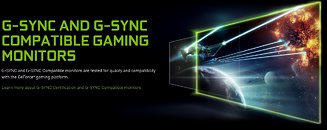Thursday, April 18th 2019

NVIDIA Adding 7 "G-Sync Compatible" Monitors to Its Listing on April 23rd
NVIDIA has confirmed that seven new monitors will be receiving the "G-Sync Compatible" badge come April 23rd. These FreeSync monitors have thus been certified by NVIDIA to work flawlessly with their implementation of VRR outside of the need of a dedicated, expensive G-Sync module.
Three of these monitors are manufactured by Acer (KG271 Bbmiipx, XF240H Bmjdpr, and XF270H Bbmiiprx), one from LG (27GK750F (AUSUMPM / BKRUMPN)), one from ASUS (VG248QG), one from Gigabyte (Aorus AD27QD) and finally, one from AOPEN (27HC1R Pbidpx). If you are rocking any of these alongside an NVIDIA graphics card, you can enable VRR already, but for those who still haven't done so, know that your is one of the lucky few monitors to have NVIDIA's compatibility badge.
Source:
via Tom's Hardware
Three of these monitors are manufactured by Acer (KG271 Bbmiipx, XF240H Bmjdpr, and XF270H Bbmiiprx), one from LG (27GK750F (AUSUMPM / BKRUMPN)), one from ASUS (VG248QG), one from Gigabyte (Aorus AD27QD) and finally, one from AOPEN (27HC1R Pbidpx). If you are rocking any of these alongside an NVIDIA graphics card, you can enable VRR already, but for those who still haven't done so, know that your is one of the lucky few monitors to have NVIDIA's compatibility badge.

45 Comments on NVIDIA Adding 7 "G-Sync Compatible" Monitors to Its Listing on April 23rd
www.amd.com/en/technologies/free-sync-faqEven AMD has a list of monitors: www.amd.com/en/products/freesync-monitors
Do they have a evil plan too? Or you can accept that some monitors are just marketing? Is 40-60 Hz "good enough"?
That's why HDMI is still present on gaming cards, but is not present on professional ones. DP has specific features for computer usage, while HDMI has for TV/Audio devices control.
The only reason why NVIDIA doesn't certify monitors like AMD is because they invested a lot of money into building G-Sync as a premium brand. FreeSync, on the other hand, is just a VRR implementation trademark.
So, yeah, in theory FreeSync and FreeSync 2 shouldn't have a limit, but obviously in practice it can, often does.
Why cant Nv hardware run the same as AMD's, even if it needs a displayport firmware update like they did a few months back
Watching my son's (23-29) ... they all play w/ G-Sync switched off in 144 / 165 hz IPS 1440p screens in 9 outta every 10 games. Most of the folks we've built for report the same. Only when they drop below around 75 hz do the turn ULMB off and use G-Sync. I do the same and, but at 1080p, I can get away with using MBR on everything.
See: www.displayninja.com/freesync-monitor-list/
Many monitors sport 40-60 or 48-75Hz range.